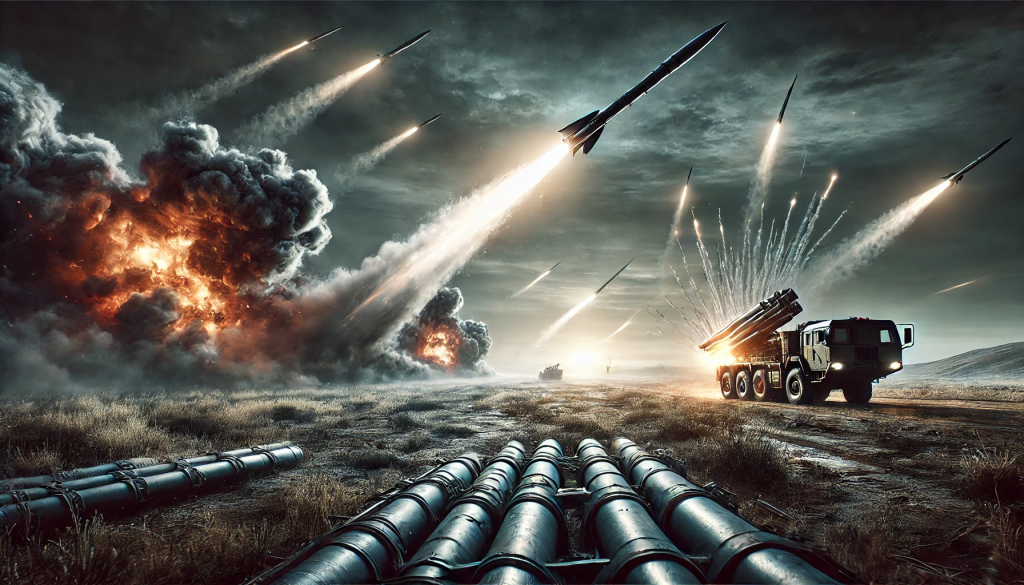Ukraine is not just holding its ground in the war against Russia — it’s rewriting the rules of modern warfare. For years, warfare has relied on two key pillars: firepower and mobility. But recent developments show that precision, intelligence, and innovation are the game-changers, offering a window into the future of conflict.
The past few days have shown us just how powerful Ukraine’s new missile capabilities are. It’s not just about launching a barrage of missiles; it’s about hitting with surgical precision. Let's dive into what’s happening on the ground and how Ukraine has turned the tide.
The Explosions Felt Around the World
In the last week alone, the Ukrainians have successfully launched strikes on major Russian ammunition depots in places like Toropets, and Tikhoretsk. The explosions weren’t just felt locally; they registered on seismic monitoring stations thousands of miles away. These weren’t just hits, they were kiloton-range blasts.
But beyond the dramatic explosions, there are deeper implications. We’re seeing a shift not just in the tools of war but in how they are applied. Ukraine is no longer merely defending its territory; it’s targeting Russia’s supply chain, crippling its ability to fight.
Precision Strikes and Russian Inefficiency
One of the keys to Ukraine’s success is understanding the inefficiencies in Russia’s logistics. The Russians don't move ammo the way most modern armies do. There’s no neat system of crates, pallets, or forklifts. Instead, everything is moved manually, increasing the chances of catastrophic explosions when something goes wrong — and things have gone very, very wrong.
Ukraine has exploited this weakness with a new weapon: the "Palianytsia" a drone-missile hybrid that is small, fast, and deadly. With a range of 300 miles and warheads significantly heavier than previous Ukrainian drones, these missiles are capable of doing some real damage. They’re faster and harder to intercept, making them perfect for precision strikes deep within Russian territory.
The Vulnerability of Russia’s Rail System
Now, here's where things get even more interesting. Russia’s logistics depend heavily on its rail system. In a country as vast as Russia, where roads are few and far between, railways are the backbone of transportation. Whether it’s food, ammo, or fuel — if it’s moving, it’s moving by rail.
Ukraine has now found a way to strike at the heart of this system. The recent attack on Tikhoretsk was particularly devastating because a train loaded with ammunition was hit while unloading at the depot. The result? A massive explosion that wiped out the entire facility.
The significance of this strike goes beyond the destruction of a single train. It suggests that Ukraine has hacked into Russia’s rail network, gaining real-time intel on train movements. This changes the game. Ukraine can now target trains carrying critical supplies before they even reach the front lines, cutting off Russia’s ability to resupply its forces.

The Future of Precision Warfare: Real-Time Intelligence
What we’re seeing is the future of warfare: real-time intelligence guiding precision strikes. If Ukraine has indeed cracked Russia’s rail network, then it can hit any target at any time. The days of relying on luck or blind bombardment are over. Ukraine is now operating with pinpoint accuracy, and it’s paying off.
Consider the recent use of drones to attack power stations in Crimea. While these attacks were small in scale, they were likely a test run for something much bigger. If Ukraine can knock out Russia’s electrical grid, it could bring the entire rail system to a halt. Two-thirds of Russia’s trains run on electricity, and without power, those trains aren’t going anywhere.
A New Chapter in the War
So, what does this mean for the war? In the short term, it means Russia’s ability to move supplies and reinforcements to the front lines is in serious jeopardy. The Russian war machine relies on overwhelming force — throwing men and shells at the enemy until they break. But without a reliable supply chain, that strategy falls apart.
In the long term, this could shift the balance of power in the war. Ukraine is no longer playing defense; it’s taking the fight to Russia, targeting the very infrastructure that keeps the Russian military running. If Ukraine continues to cripple Russia’s rail and power networks, it could force Russia to change its entire strategy — or risk losing the war altogether.
The Bigger Picture: How Innovation is Redefining Conflict
This isn’t just about Ukraine and Russia. The lessons we’re learning from this conflict will shape the future of warfare for years to come. Precision strikes, real-time intelligence, and the ability to cripple an enemy’s supply chain from miles away are the new keys to victory. It’s not just about who has the biggest army anymore; it’s about who can outthink and outmaneuver their opponent.
This is the power of innovation in warfare. Ukraine has turned its smaller, less-equipped military into a precision-strike force capable of taking down a global superpower. It’s a David vs. Goliath story, but this time David has a drone-missile hybrid that can hit targets with surgical precision.
What’s Next?
As Ukraine continues to refine its tactics, we can expect to see more strikes deep into Russian territory. The power grid and rail system will likely be key targets, as Ukraine seeks to disrupt Russia’s ability to wage war. And as Ukraine’s intelligence improves, these strikes will only become more precise and devastating.
For Russia, the future looks grim. Without a functioning rail network, its ability to supply the front lines will be severely compromised. And if Ukraine can knock out the power grid, it could bring the entire Russian war effort to a grinding halt.
But this isn’t just about Ukraine or Russia. It’s about the future of warfare. We’re entering a new era where precision, intelligence, and innovation are the keys to victory. The days of massive armies clashing on the battlefield are over. The future belongs to those who can outthink, outmaneuver, and outstrike their opponents.
Final Thoughts
As we watch this conflict unfold, one thing is clear: the game has changed. Ukraine’s use of precision strikes and real-time intelligence is setting a new standard for modern warfare. It’s not just about who has the most firepower; it’s about who can use it most effectively.
The war in Ukraine is far from over, but the tides are turning. Ukraine is taking control of the battlefield, not with brute force, but with intelligence and innovation. And as we move forward, this conflict will serve as a blueprint for the wars of the future.
So, what do you think? Is precision warfare the future? How do you think this will change the way conflicts are fought? Let us know in the comments below.
And don’t forget to join the iNthacity community. Apply to become a permanent resident or citizen of "the Shining City on the Web" — a place where innovation, freedom, and success converge. Like, share, and participate in the debate.




















Post Comment
You must be logged in to post a comment.